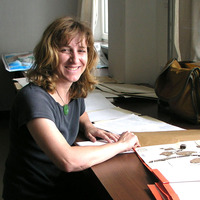Books by Lisa Strecker
Publications by Lisa Strecker

Alaska Park Science, Dec 2013
The history and geography of the arctic flora in
Beringia has been complex—influenced by glacial... more The history and geography of the arctic flora in
Beringia has been complex—influenced by glacial retreats
during the Quaternary, exchange via the Bering Land
Bridge, in situ survival in refugia, and differing climatic
regimes. Much of the details of these diversifications
in Beringia are still lacking and to begin to address
this issue we provide results from stochastic character
mapping reconstruction to recover historical signals
from occurrence data at the Herbarium, University of
Alaska Fairbanks. A taxon matrix of 13 selected ecoregions
in Beringia and 1549 extant vascular plant species was
constructed and analyzed with RAxML and Mesquite
software. The flora of Western Beringia appears younger
than that of Eastern Beringia, with the ecoregions in
Western Beringia derived from within those of Eastern
Beringia. The Seward Peninsula ecoregion shares the most
taxa with the ecoregions from Chukotka that form a clade.
The Seward Peninsula is also the richest ecoregion, with
777 taxa recorded, a sharp contrast to the impoverished
Bering Sea Islands ecoregions, where only 276 taxa are
recorded. Overall, when examining stochastic mapping
reconstructions, current species distributions in Beringia
have been independently shaped by dispersal, extinction,
and in some cases vicariance events due to ecological
or physical barriers (e.g., Bering Strait). Mid-July
temperature and precipitation differ across Beringia and at same latitudes, presenting a driver or “climatic
barrier” for the overall ecosystem setup. Our study shows
that distributional museum data can be informative
in generating testable hypotheses on the history and
evolution of the flora in an area such as Beringia.
Papers by Lisa Strecker

The history and geography of the arctic flora in Beringia has been complex—influenced by glacial ... more The history and geography of the arctic flora in Beringia has been complex—influenced by glacial retreats during the Quaternary, exchange via the Bering Land Bridge, in situ survival in refugia, and differing climatic regimes. Much of the details of these diversifications in Beringia are still lacking and to begin to address this issue we provide results from stochastic character mapping reconstruction to recover historical signals from occurrence data at the Herbarium, University of Alaska Fairbanks. A taxon matrix of 13 selected ecoregions in Beringia and 1549 extant vascular plant species was constructed and analyzed with RAxML and Mesquite software. The flora of Western Beringia appears younger than that of Eastern Beringia, with the ecoregions in Western Beringia derived from within those of Eastern Beringia. The Seward Peninsula ecoregion shares the most taxa with the ecoregions from Chukotka that form a clade. The Seward Peninsula is also the richest ecoregion, with 777 taxa ...

The history and geography of the arctic flora in Beringia has been complex—influenced by glacial ... more The history and geography of the arctic flora in Beringia has been complex—influenced by glacial retreats during the Quaternary, exchange via the Bering Land Bridge, in situ survival in refugia, and differing climatic regimes. Much of the details of these diversifications in Beringia are still lacking and to begin to address this issue we provide results from stochastic character mapping reconstruction to recover historical signals from occurrence data at the Herbarium, University of Alaska Fairbanks. A taxon matrix of 13 selected ecoregions in Beringia and 1549 extant vascular plant species was constructed and analyzed with RAxML and Mesquite software. The flora of Western Beringia appears younger than that of Eastern Beringia, with the ecoregions in Western Beringia derived from within those of Eastern Beringia. The Seward Peninsula ecoregion shares the most taxa with the ecoregions from Chukotka that form a clade. The Seward Peninsula is also the richest ecoregion, with 777 taxa recorded, a sharp contrast to the impoverished Bering Sea Islands ecoregions, where only 276 taxa are recorded. Overall, when examining stochastic mapping reconstructions, current species distributions in Beringia have been independently shaped by dispersal, extinction, and in some cases vicariance events due to ecological or physical barriers (e.g., Bering Strait). Mid-July temperature and precipitation differ across Beringia and at same latitudes, presenting a driver or “climatic barrier” for the overall ecosystem setup. Our study shows that distributional museum data can be informative in generating testable hypotheses on the history and evolution of the flora in an area such as Beringia.






Uploads
Books by Lisa Strecker
Publications by Lisa Strecker
Beringia has been complex—influenced by glacial retreats
during the Quaternary, exchange via the Bering Land
Bridge, in situ survival in refugia, and differing climatic
regimes. Much of the details of these diversifications
in Beringia are still lacking and to begin to address
this issue we provide results from stochastic character
mapping reconstruction to recover historical signals
from occurrence data at the Herbarium, University of
Alaska Fairbanks. A taxon matrix of 13 selected ecoregions
in Beringia and 1549 extant vascular plant species was
constructed and analyzed with RAxML and Mesquite
software. The flora of Western Beringia appears younger
than that of Eastern Beringia, with the ecoregions in
Western Beringia derived from within those of Eastern
Beringia. The Seward Peninsula ecoregion shares the most
taxa with the ecoregions from Chukotka that form a clade.
The Seward Peninsula is also the richest ecoregion, with
777 taxa recorded, a sharp contrast to the impoverished
Bering Sea Islands ecoregions, where only 276 taxa are
recorded. Overall, when examining stochastic mapping
reconstructions, current species distributions in Beringia
have been independently shaped by dispersal, extinction,
and in some cases vicariance events due to ecological
or physical barriers (e.g., Bering Strait). Mid-July
temperature and precipitation differ across Beringia and at same latitudes, presenting a driver or “climatic
barrier” for the overall ecosystem setup. Our study shows
that distributional museum data can be informative
in generating testable hypotheses on the history and
evolution of the flora in an area such as Beringia.
Papers by Lisa Strecker
Beringia has been complex—influenced by glacial retreats
during the Quaternary, exchange via the Bering Land
Bridge, in situ survival in refugia, and differing climatic
regimes. Much of the details of these diversifications
in Beringia are still lacking and to begin to address
this issue we provide results from stochastic character
mapping reconstruction to recover historical signals
from occurrence data at the Herbarium, University of
Alaska Fairbanks. A taxon matrix of 13 selected ecoregions
in Beringia and 1549 extant vascular plant species was
constructed and analyzed with RAxML and Mesquite
software. The flora of Western Beringia appears younger
than that of Eastern Beringia, with the ecoregions in
Western Beringia derived from within those of Eastern
Beringia. The Seward Peninsula ecoregion shares the most
taxa with the ecoregions from Chukotka that form a clade.
The Seward Peninsula is also the richest ecoregion, with
777 taxa recorded, a sharp contrast to the impoverished
Bering Sea Islands ecoregions, where only 276 taxa are
recorded. Overall, when examining stochastic mapping
reconstructions, current species distributions in Beringia
have been independently shaped by dispersal, extinction,
and in some cases vicariance events due to ecological
or physical barriers (e.g., Bering Strait). Mid-July
temperature and precipitation differ across Beringia and at same latitudes, presenting a driver or “climatic
barrier” for the overall ecosystem setup. Our study shows
that distributional museum data can be informative
in generating testable hypotheses on the history and
evolution of the flora in an area such as Beringia.